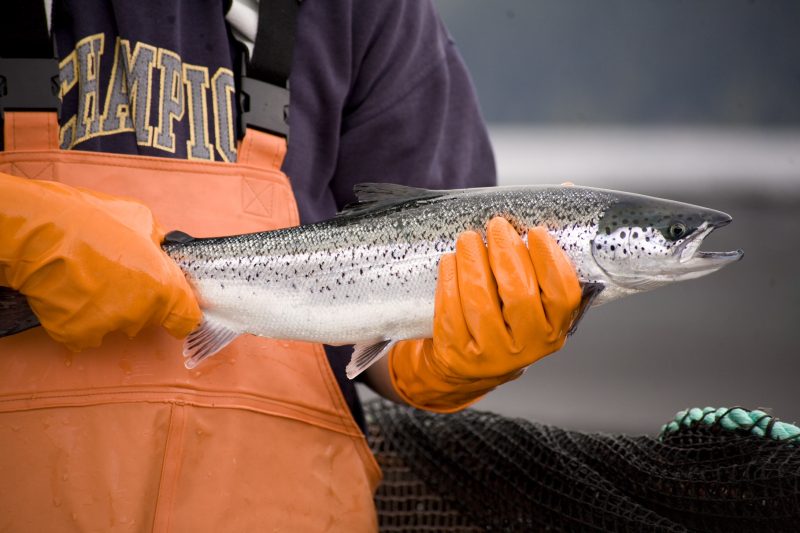Why the world needs more aquaculture
Significant increase in demand predicted for farmed salmon and other aquaculture products by leading European experts and a new report
By Fabian Dawson
SeaWestNews
The sustainable fish of the future will come from fish farms say leading European scientists and a new analysis on the global aquaculture market.
All of them conclude that fish production via aquaculture is increasing worldwide because of growing seafood consumption paired with rising economic importance associated with fisheries.
“The hundreds of millions of tonnes of extra fish we will need will have to come from fish farms,” said Dr. Johan Verreth professor of Aquaculture and Fisheries at his farewell lecture at Netherlands-based Wageningen University & Research.
Fish production via aquaculture is increasing worldwide. In 2015, the 70 million tonne yield was comparable to that of wild fisheries, but higher than that of beef production.
“It wouldn’t surprise me if aquaculture exceeds chicken farming (90 million tonnes) and pig farming (100 million tonnes) in the near future. Half of all fish we consume on an annual basis comes from aquaculture. That makes fish our primary source of animal protein,” said Professor Verreth.
He called for heavy investment in aquaculture innovation in order to achieve 100 million tonnes of extra fish for the world.
“Will we have enough fish to feed the growing global population in twenty years? Not if that fish comes from wild fisheries,” he concluded.
Similarly, a new report on the global aquaculture market predicts farmed fisheries will surpass the capture fisheries market as the primary source for seafood consumption in the coming years.
The global aquaculture market is expected to be valued at USD 202.96 billion by 2020, said Million Insights, according to a press release.
“The depleting volume of captured fish in the global reserves due to extensive fishing in the past two to three decades is considered as one of the major driving factors for industry growth,” the report’s authors said.
“Growing consumer concerns associated with the consumption of fish and other fish products followed by a surge in consumption of fish is expected to spur product demand over the next few years.”
The industry is anticipated to witness significant demand for farmed salmon, given its rich content of omega-3 fatty acids, vitamin D and protein and considered globally as a healthy food, the report said.
In Europe, scientists studying the impact of climate change on the oceans are working towards sustainable growth in future seafood production.
“It is critical to understand how Europe’s aquaculture industry and EU policy will need to adapt to foster Blue Growth in light of climate change,” said Professor Myron Peck from Universität Hamburg in Germany, referring to the European Union‘s long term economic strategy for a sustainable marine sector.
Europe is the fourth largest producer of fish in the world, according to Eurostat, with about 6.4 million tonnes of fish and shellfish caught or harvested by the European fisheries and aquaculture industry in 2015. Approximately 80% of European aquatic food production comes from wild fisheries, while around 20% comes from aquaculture, or fish farms.
Professor Michaela Aschan from University of Tromsø – The Arctic University of Norway, who is also project coordinator of ClimeFish, explains the need for projects focusing on sustainable food production.
“The demand for healthy, protein-rich food is growing along with the world’s population,’ she said.
“Wild fish stocks are declining, climate change will severely reduce the outcome from agriculture, and aquaculture is predicted to become the main supplier for food in the future. However, climate adaptation plans in this sector is lacking and there are still large knowledge gaps.”
She and her colleagues are forecasting the future growth for 16 different case studies, including the most productive and the least resilient species used for seafood in Europe.
Another European Union project called CERES, is looking at the most high-value fish and shellfish populations across European waters, and how climate change will impact them, their habitats and economic activities in the future.
The project, named after the Roman goddess of agriculture and fertility, also works closely with both wild and farmed sectors to examine how they can adapt to these adverse changes, as well as potentially benefit from them.
CERES offers the opportunity to build strong relationships between scientists studying climate change and the leaders of Europe’s aquaculture industry. It employs business-proven methods, such as risk assessment, to create actionable science — science that is fit for purpose and can be used by policymakers and the aquaculture industry.
RELATED LINKS
A common vision to protect wild salmon
Ottawa in search of few good experts on aquaculture science

